| «Black Ostrava» was a famous song about the city during Communism. It was about an industrial, polluted and hard working city. When industry collapsed the city and the region started rebranding and now they offer many great things to do and see. |

Jun 2012 |
|
 |
 |
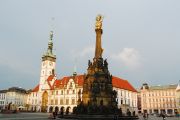 |
 |
 |
 |
 |
 |
The Upper Square with the Holy Trinity Column in Olomouc
 |
 |
For most of the people, the Czech Republic is only Prague. It is a very unfair opinion as this small country located in Central Europe between Poland, Slovakia, Austria and Germany has much more to offer to the traveller. Like every country in this region of Europe, the Czechs have a very complicated history, especially during the XX century. They regained independence after 392 years of being a part of foreign empires, then were left alone by the allies to Hitler (Sudetenland is still a very sensitive issue) and after World War II they were abandoned in the hands of the Communists. Last major change was in 1993, when the Velvet Revolution split Czechoslovakia into two countries. Despite all this, Czechs avoided massive war destructions and today its urban areas are among the prettiest in Europe. Prague is the capital; Brno, Ostrava, Olomouc are other bigger cities.
Czechs describes themselves as the most atheist society in the world. The Catholic Church was never very strong here and even the last pilgrimage of Benedict XVI did not bring many changes. Vaclav Klaus is the President and, together with the Hungarian President, is the most euro sceptic in the EU. However, thanks to EU money the Czech Rep. develops quickly. Ceska Koruna (1 EUR -25 KC) is the national currency and it doesn't seem that it will be replaced soon by the euro. The country is divided into three historical lands: Bohemia (on the west), Moravia (on the east) and Silesia (on the north). On my trip, I visited Silesia and Moravia. Those regions are full of UNESCO treasures; like the Kromeriz Palace and Gardens, the Jewish Quarter and St. Procopius basilica in Trebic, the Renaissance old town in Telc, the Tugendhat Villa in Brno, the Holy Trinity column in Olomouc, the Litomysl Castle and the Lednice Valtice Cultural Landscape. Travelling around is easy, there is a good network of motorways (although special "vinieta" is obligatory), trains and busses. Brno and Ostrava have international airports.
|
|
| Favourite spots: |
 |
 |
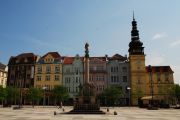 |
 |
 |
 |
 |
 |
Masarykovo Namesti in Ostrava.
 |
 |
It is difficult to write beautifully about an ugly city. But Ostrava is undergoing a huge transformation. The biggest attraction is an Old Town Hall, which is nothing compared to other town halls in the Czech Republic, and the main square that is surrounded by few pretty buildings. However, Ostrava in a few years can be on the list of `not to be missed` points in Europe. A city that lived from industry and mining had to look for a new identity and the road taken (focusing on culture and know-how) seems to be very promising. The development of the city started in the XIX century, together with the growth of mining and industry. Thanks to `black gold`, the city financed (among others) the New Town Hall, which was very imposing for its time. It is an impressive building with two wings and a central part with a steel framed 86 metres high observation tower (50KC). Another place is the Silesian Ostrava Castle. Its structure lately sank 16m into the ground due to the coal mining beneath it.
|
|
| What's really great: |
 |
 |
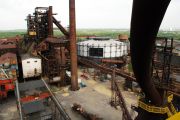 |
 |
 |
 |
 |
 |
Vitkovice area with gas container converted into a concert hall.
 |
 |
One of the places where we can see the changes in Ostrava is the Vitkovice area. It used to be the most industrial and polluted place in the Czech Republic. After the change of the political regime, most of the industry collapsed. The city was left with dozens of closed coalmines, steel work factories and other heavy industry companies. As the “steel heart of the republic” stopped to beat, the city started to look for a new identity. They decided to turn onto the culture and the entire area of Vitkovice is undergoing massive reconstruction. The first part of the steel work complex is already transformed into an open-air museum and it is possible to sightsee it with a guide. The giant container for blast furnace gas has been rebuilt as a concert hall for 1.500 visitors and the energy central office will become the industrial museum. Landek Park (former Anselm Mine) is the largest mining museum in the Czech Republic, it being possible to see there the harsh working conditions of miners.
|
|
| Sights: |
|
Without any doubts, Olomouc is a hidden treasure of the eastern part of the Czech Republic. It has a stunning historical centre, almost untouched by the communist, with the Holy Trinity Column (a 32 m high structure). Some say that Julius Cesar founded Olomouc, but it is only a legend. The fact is that the city, for some moment in the 12th century, was the capital of the Moravian Kingdom. After that, the city was an important fortress on the road between Krakow and Prague. Nowadays, being off the beaten track (as for Czech standards), the city is a pleasant change from Prague crowds. The Upper Square (Hlavni Namesti) is a main point on the map, dominated by a huge Town Hall (built in 1378), surrounded by beautiful houses and dotted with gorgeous city fountains. The Astronomical clock, which is on the north side of the Town Hall is a unique worldwide example of how the communist replaced saints and angels by scientists and labourers. St. Wenceslas Cathedral is the biggest church in town
|
|
| Accommodations: |
 |
 |
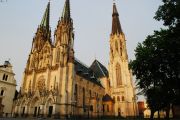 |
 |
 |
 |
 |
 |
St. Wenceslas Cathedral in Olomouc
 |
 |
Honestly, it was the biggest disappointment during the entire trip. As we went there by car, we didn´t make any reservations, which turned out to be a mistake. The Moravia Region doesn´t have that many budget places to sleep. In Olomouc, the only one hostel (~ 40 eur per room) didn´t accept the guests for only one night. Other cheaper options (~ 50-60 eur per double) were also full. The only Ibis hotel in town charges more than 90 eur!!! per room. Almost being hopeless, we went to hotel Palac (Tr. 1. máje 869/27, tel +420 585 242 175), which seemed to be also very expensive. However, they charged only 47 eur per double, which was a great option for Olomouc. In Brno, we had exactly the same situation - two (not cheap) hostels were full, so we ended up in Pension Venezia (60 eur per double, ask in nearby pizzeria for the keys, they don´t have reception). They offer old, socialist style but clean apartments in the city centre. The earplugs are necessary, as the hotel is above a disco.
|
|
| Nightlife: |
 |
 |
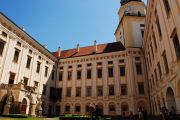 |
 |
 |
 |
 |
 |
The courtyard of Kromeriz Archbishops Palace
 |
 |
The church used to be greedy and haughty, which is contrary to its main doctrine. However, thanks to it, Europe received many splendid buildings. One of the best examples is The Archbishop's Palace in Kromeriz (subscribed to UNESCO list). Bishop Stanislas Thurzo built it in 1497, it was destroyed during the Thirty Years' War and then belonged to the powerful Liechtenstein family. The Kromeriz Palace is still proud of its marvellous interiors - library being the most well known with 40 thousand books (two way of seeing, with a guide costs 8 eur, or by your own way 3 eur). The palace is surrounded by the romantic, 64-hectare gardens. The numerous ponds (connected to the Morava River), together with other buildings, make it a perfect place for walking in summer and skating in wintertime. The last piece of the Unesco list is the Flowers Garden (located 1 km from the Palace). One of the most beautiful baroque gardens in the Czech Republic, it is a labyrinth of alleys, dotted with fountains
|
|
| Hangouts: |
The northern Moravia is not only about the cities. The area is full of small towns, romantic castles or pretty villages.
Bouzov Castle is a fairytale, Teutonic style castle, located only 38 kilometres from Olomouc. It is located on a hilltop with a stunning view and surrounded by a huge park. The castle was built in 14th century and, from 17th century, it was one of the main seats of the Teutonic Order. The buildings are grouped around it in the form of a horseshoe, and a number of towers and among other things, bastions, battlements, oriels windows and loopholes enhance the castle. The entrance is paid and with a guide.
Sternberk Castle is located 300 metres up from the town main square. It belonged to the Liechtenstein family. It has the historical interiors from Gothic to baroque (entrance guided 3 eur). Another interesting building in Sternberk is the Parish Church of the Annunciation of Our Lord, recently renovated. There is a keys keeper, which showed us the church for free.
|
|
| Restaurants: |
 |
 |
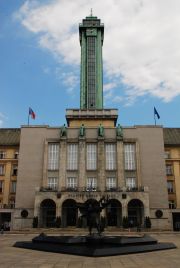 |
 |
 |
 |
 |
 |
The New Town Hall in Ostrava
 |
 |
Czech food is typical in this part of Europe. Heavy diet based on meat, potatoes, cabbage and knedliky (a kind of dumplings) can be tricky for healthy ones. Luckily, for them in most of the cities restaurants with international cuisine can be found. In Moravia, we had problems to find cafeterias with breakfast. A lot of them were serving already the typical lunch/dinner for breakfast.
More than for the food, the Czechs are worldwide known for the beer. They are the 3rd biggest beer consumer per person in the world. The greatest breweries and types of beer are from here, among which the leaders are: Pilsner, Budweiser (they still have an international dispute with the American brewery about the name), Staropramen, Radegast from Ostrava and Kozel from Velike Popovice. The Czechs introduced the gradation of beer strength. The 10, 11 are lighter but 14 is already for strong heads. Moravia is famous for the wine. The lands around Brno are surrounded by vineyards producing good Riesling.
|
|
| Other recommendations: |
 |
 |
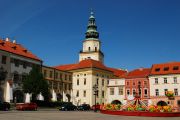 |
 |
 |
 |
 |
 |
The main suqare in Kromeriz
 |
 |
Czech art and literature. Jan Saudek is a great modern photographer and painter, who show in a pretty way the ugliness of a daily life. Nudity is the main subject on his works. Most of the pictures were done in a pavement in front of an old wall. He decided not to repair it for more than 40 years. It is one of the reasons making his art unique. The main museum of Saudek art is in Prague but his pictures can be found everywhere. www.saudek.com is his website.
Josef Sudek is another famous photographer. His main object is nature. The pictures from the earliest period of his career are in most of the photography schoolbooks.
David Cerny is a modern artist, sculptor. The Czech Rep. is dotted with his works, like the old Trabant car with legs in the German embassy, baby statues on a TV tower in Prague, a bus stop in the shape of a table in Liberec.
Vaclav Havel is one of the few presidents who published books before being elected.
The great movies of Jan Sverak like «Kolya»and «Empties»
|
|
Published on Saturday June 30th, 2012
|
|
 Publish on Facebook
Publish on Facebook
|
Sat, Feb 16 2013 - 06:59 PM
 by ulfpe
| Nicely written, I know the area very well. But isn't the title a bit missleading, it more about Olomuc |
Mon, Nov 26 2012 - 12:45 PM
 by krisek by krisek
| Ostrava has never been on my list of paces to visit. How interesting... Thank you for your detailed report! |
Thu, Aug 16 2012 - 09:39 AM
 by bootlegga by bootlegga
| Great photos and an interesting report! |
Mon, Jul 23 2012 - 06:51 PM
 by eirekay by eirekay
| Wonderful Report with lots of detail. Interesting to see how religion and/or the lack there of, really shaped the region! |
Sun, Jul 01 2012 - 10:18 AM
 by marianne by marianne
| Excellent information, you covered many interesting places in this report. After reading about Ostrava it is even higher on my want-to-go list. Did you see the Trabant car in the garden of the German Embassy? It looks quite funny. If you haven't seen it yet, be sure to check it out in winter. When the trees are in full leaves, they hide the work of art. |
Sun, Jul 01 2012 - 04:04 AM
 by pesu by pesu
| Well-written, knowledgable, highly informative report - a pleasure to read, Rafal! I don't have a problem with your free interpretation of the captions.:) Great photos as well. Thank you! |
| Information: |
| Login if you are a member, or sign up for a free membership to rate this report and to earn globo points! |
|
| Bolivia |
|
|
 |
| Cambodia |
|
|
 |
| Chile |
|
|
 |
| China |
|
|
 |
| Czech Republic |
|
|
 |
| France |
|
|
|
|
|
|
|
|
 |
| Hungary |
|
|
 |
| Lithuania |
|
|
 |
| Macedonia |
|
|
 |
| Portugal |
|
|
|

|
